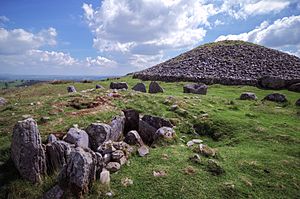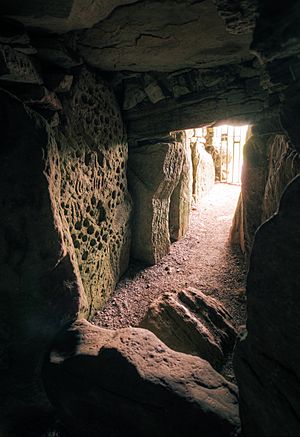Loughcrew facts for kids
Loughcrew or Lough Crew (Irish: Loch Craobh, meaning lake of the tree) is a very old and important place in County Meath, Ireland. It's famous for its group of huge stone tombs called megalithic tombs. These tombs are super old, built around 3300 BC! They sit on top of a range of hills. These hills and the tombs are known as Slieve na Calliagh (Sliabh na Caillí). This name means "mountain of the Cailleach" or "mountain of the hag." It's the highest point in County Meath. Loughcrew is one of Ireland's main passage tomb sites and is a protected National Monument. The area also has the Loughcrew Estate, which gave the place its name.
Contents
Ancient Tombs at Loughcrew
Loughcrew is one of four major passage tomb sites in Ireland. The other famous ones are Brú na Bóinne, Carrowkeel, and Carrowmore. The tombs at Loughcrew are spread out over four hilltops: Carnbane East, Carnbane West, Carrickbrack, and Patrickstown.
The Legend of the Cailleach
The hills and tombs are called Slieve na Calliagh, which means "mountain of the Cailleach". The Cailleach is a powerful, wise old woman from Irish mythology. A fun legend says that these huge monuments were made when a giant hag was walking across the land. She was carrying a lot of big stones in her apron. As she walked, she dropped the stones, and that's how the tombs were formed!
What the Tombs Look Like
Even though we don't have exact dates for all of them, experts believe these tombs were built around 3300 BC. Most of the tombs have a cross-shaped room inside, covered by a big mound of earth and stones. You can see special carvings called petroglyphs on the stones. These unique designs include diamond shapes, leaf shapes, and circles. Some circles even have lines coming out like sunbeams!
The stones used for the tombs are from local green gritstone. This stone was soft enough for ancient people to carve. But because it's soft, it can also be damaged easily. Old Irish stories say it's very bad luck to harm or disrespect these ancient tombs. Doing so could bring a curse!
Sunlight and the Tombs
In 1980, a researcher named Martin Brennan made an amazing discovery. He found that Cairn T, one of the tombs on Carnbane East, is built to catch the rising sun's rays. On the spring and autumn equinox (when day and night are about equal length), the sunlight shines right down the passage. It lights up the beautiful carvings on the back stone inside the tomb! This is similar to the famous Newgrange tomb at Brú na Bóinne, which is lit up by the winter solstice sunrise.
There are about twenty-three tombs in the Loughcrew area, including Cairn L and Cairn T. There are also other ancient sites nearby.
Loughcrew's Recent History
In more recent times, Loughcrew became home to a branch of the Norman-Irish Plunkett family. The most famous person from this family was St Oliver Plunkett, who became a saint. The family church is still standing in the beautiful Loughcrew Gardens.
A Secret Meeting Place
Because Sliabh na Caillí was a quiet and isolated place, it became very important during the Penal Laws. These were laws that made it hard for Roman Catholics to practice their religion freely. So, Sliabh na Caillí became a secret meeting spot for them. Even though the old woods are gone now, you can still see a "Mass Rock" on top of Sliabh na Caillí today. This was a special stone where priests would hold secret church services.
The Naper Family and the Estate
The Plunkett family lost their land in the 1650s. Then, the Naper family took over the Loughcrew estate around 1655. Over the next few centuries, the Napers built a huge estate of about 180,000 acres in north Meath.
After a big fire in 1964, the Naper family decided to divide the estate. Today, Charles and Emily Naper have worked hard to restore the house and gardens. They now open the gardens for visitors and even host an annual opera festival there!
Images for kids
See also
 In Spanish: Loughcrew para niños
In Spanish: Loughcrew para niños







